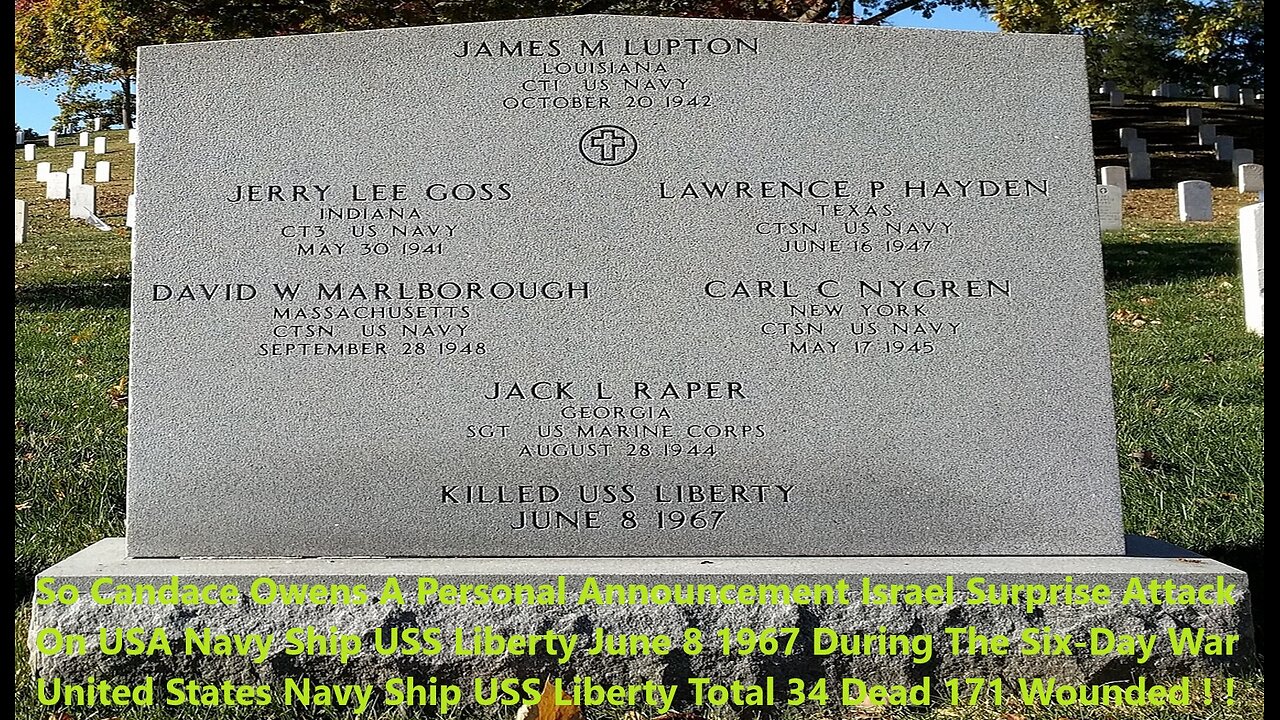Premium Only Content

Candace Owens A Personal Announcement Israel Surprise Attack On US Navy Ship USS Liberty 1967
So Candace Owens A Personal Announcement A True Story About Israel Surprise Attack On USA Navy Ship USS Liberty June 8 1967 During The Six-Day War United States Navy Ship USS Liberty Total 34 Dead 171 Wounded and this is a true incident was an attack on a United States Navy technical research ship (spy ship), USS Liberty, by Israeli Air Force jet fighter aircraft and Israeli Navy motor torpedo boats, on 8 June 1967, during the Six-Day War. The combined air and sea attack killed 34 crew members (naval officers, seamen, two marines, and one civilian NSA employee), wounded 171 crew members, and severely damaged the ship. At the time, the ship was in international waters north of the Sinai Peninsula, about 25.5 nmi (29.3 mi; 47.2 km) northwest from the Egyptian city of Arish.
Israel Surprise Attack On United States Navy Ship USS Liberty 34 Dead 171 Wounded - https://rumble.com/v3op5v1-israel-surprise-attack-on-united-states-navy-ship-uss-liberty-43-dead-171-w.html - Israel Surprise Attack On United States Navy Ship USS Liberty incident was an attack on a United States Navy technical research ship (spy ship), USS Liberty, by Israeli Air Force jet fighter aircraft and Israeli Navy motor torpedo boats, on 8 June 1967, during the Six-Day War.
One of the biggest problems Americans have is that they are all still falling for the Left Vs Right paradigm. They can’t seem to understand that BOTH parties are filled w/ Zionist puppets that are controlled by the largest lobbyist group AIPAC. Each politicians has their own “AIPAC babysitter”. We even have many politicians sitting in office who has dual citizenship w/ Israel!!!! So many Americans are blindly supporting the Zionist & Rothschild funded & created State of Israel. This State of Israel is NOT the Israel of the Bible & the Jews are NOT God chosen ones. So many ppl are clueless about the Zionist plan for the one world gov, the “Greater Israel Project”. Wake up America. Stop falling for the 2 tier party system that’s been keeping us all enslaved, distracted & divided. It’s a big uniparty… they are all actors just following their roles they’ve been given by the puppet masters. US gov is occupied by Rothschild State of Israel. Jews calling DJT “King of Israel”. Don’t be surprised when the gov enforced the 7 Noahide Laws on all goyim nationwide. Breaking any of those laws is punishment by death, beheading. If you believe in Jesus Christ, you would be breaking Law #1, idol worship.
Israel apologized for the attack, saying that the USS Liberty had been attacked in error after being mistaken for an Egyptian ship. Both the Israeli and U.S. governments conducted inquiries and issued reports that concluded the attack was a mistake due to Israeli confusion about the ship's identity. Others, including survivors of the attack, have rejected these conclusions and maintain that the attack was deliberate.
In May 1968, the Israeli government paid US$3.32 million (equivalent to US$28 million in 2022) to the U.S. government in compensation for the families of the 34 men killed in the attack. In March 1969, Israel paid a further $3.57 million ($28.5 million in 2022) to the men who had been wounded. In December 1980, it agreed to pay $6 million ($21.3 million in 2022) as the final settlement for material damage to the ship plus 13 years of interest.
https://en.wikipedia.org/wiki/USS_Liberty_incident
Israeli jet fighters hit the vessel with rockets, cannon fire and napalm, before three Israeli torpedo boats moved in to launch a second more devastating attack. Though she did not sink, the Liberty was badly damaged. Thirty-four US servicemen and civilian analysts were killed, another 171 were wounded by attack had been a catastrophic accident.
Will Tell The Truth About All Surprise Attacked 2023 On Israel By Jihad Hamas Khilafah Islamic State and Israel Surprise Attacked 1967 On Egypt.
Six Day War, 1967. On the morning of June 5, Israeli planes surprise-attacked the at-rest Egyptian air force, destroying hundreds of planes. Similar strikes hobbled Jordan and Syria. On the ground, Israeli troops marched into the Sinai Peninsula and the Gaza Strip. They routed Palestinians from the West Bank of the Jordan River, seized the Golan Heights in Syria and continued on to the Suez Canal. The rapid chain of events altered the landscape and the future of the Middle East — and, arguably, foreign policy in state departments around the world.
Field Marshal Amer and the Egyptian top brass were meeting at Bir Tamada, an airbase in Sinai. They were just starting the meeting when the first Israeli jets started their bomb runs. One of the generals was so surprised by the attack that the first thing that flashed through his mind was a coup or some other kind of Egyptian betrayal.
The Japanese surprise-attack on Pearl Harbor, 1941. The morning assault by the Imperial Japanese Army on the U.S naval base in Hawaii changed the shape of the already-raging 1937 start of World War II.
The Battle of France, 1940. Hitler's Conquest of France, said that the Germans' "successful surprise attack" on France altered the way the world regarded France and the way that France regarded itself.
The headline writers at USA Today put it this way: "9/11: How One Day Changed Our World." National Geographic observed that the surprise-attacks of Sept. 11 by U.S.A. would "alter the course of history."
In August 1964, the U.S. entered the Vietnam War based on reports of an unprovoked attack in the Gulf of Tonkin — which the president knew were false. They showed that there was no attack on August 4. U.S. officials had distorted the truth about the Gulf of Tonkin incident for their own gains — and perhaps for Johnson’s own political prospects.
A LITTLE HISTORY
On June 8, 1967, Lieutenant Richard F. Kiepfer, was the lone medical doctor on board the spy ship, the USS LIBERTY, who “with complete disregard for his own personal safety, exposed himself to overwhelmingly accurate rocket and machine gun fire…administered first aid…treated [171 wounded] men for pain, shock…[and] conducted a major surgical operation” [Silver Star Medal Commendation].
Six weeks after boarding the LIBERTY, fifteen minutes into the attack and while operating on a sailor to control his bleeding, Dr. Kiepfer received eleven shrapnel wounds into his abdomen, a gun shot to his leg, burns and a broken knee cap. He remained on his feet and caring for the crew for the next twenty-eight hours and their spirits ever since.
In December 2007, I visited with 70 year old Dr. Kiepfer, a Catholic born and bred in Brooklyn, in his Texas home where the deer ignore the corn put out by his neighbors, for Dr. Kiepfer provides prime feed in his front yard. Obese raccoons dine on a daily feast of dog food and multiple cats eat better than mine, in his back yard. Friends, who check on the doctor daily, set the food out, for Dr. Kiepfer could no longer do what he once did.
A Master Bridge player while still in his teens, Dr. Kiepfer today continues to play the cards he has been dealt in life with aplomb and grace. In 1973 he nearly died in a plane crash after parachuting atop of Georgia pecan trees that ended his surgical career and the use of his right hand and arm.
“As I laid there and looked at my arm and failed every test to move it, I knew then I would never operate again and began to think about what I could do in life to continue to be useful, and decided on nuclear medicine. The pilot landed a mile away from me, and was impaled on a forest of pine trees.”
After twenty years in nuclear medicine he retired after suffering a heart attack and since then has suffered the loss of two wives, but not his sense of humor, which borders on the ribald. My weekend visit with Dr. Kiepfer in his home adorned with icons of St. Francis occurred only a week after his discharge from a rehabilitation center. He had spent the last six months recuperating from a below the knee amputation.
Retired Commander David Ed Lewis who had been the officer in charge of 195 men out of the total crew of 294 on the US LIBERTY, told me, “I know Doc has suffered more and complained less than anyone I know. Job didn’t have much on Doc. He has always dedicated his life to others and has never asked anything in return from them.”
The book of Job is a critique about the justice of God in light of suffering and finding meaning and value in that pain and not playing a blame game and I learned that Keipfer certainly qualifies.
I also had many questions for Dr. Kiepfer, and utmost was what was left out of the Court of Inquiry: such as how could the deck log which documents the hours during the attack be so neatly written and list all the dead and wounded in alphabetical order within the hours of noon to four PM but make no mention of the many Israeli over flights that occurred during the morning before the attack.
Dr. Kiepfer explained, “The deck log was not written during the attack. Captain McGonagle signed off on the Log and that makes it legal, but not authentic. McGonagle was concerned that he would be blamed for the LIBERTY being in troubled waters. I told him, ‘Over my dead fucking body!'”
After the hellacious and unprovoked attack by Israel, they did indeed blame the victims.
“Israel did identify the ship six hours before the attack. Israel did know that the ship was American and admitted to our government that they knew the ship was American; Israel claims only that the attacking forces failed to get the word.
“Modern diplomacy simply does not permit one to embarrass a ‘friendly’ nation, even when that nation is caught red-handed with its torpedo in one’s ship!
“McGonagle was tormented by the idea that he was somehow responsible for the agony his ship and crew suffered. One top level theory holds that someone in the Israeli armed forces ordered the LIBERTY sunk because he suspected that it had taken down messages showing that Israel started the fighting during the Six Day War.
“Typical of Israel’s casual attitude toward the episode, an attitude which suggested from the beginning that it was really our fault for being there-in international waters-in the first place.
“Messages from Israel directly charged that a share of the blame was McGonagle’s. The Shreveport Times suggested that our government was involved in a cover-up and that the attack itself may have been conducted to prevent the ship and the United States from detecting the pending invasion of Syria” which had been scheduled for June 8th but implemented on June 9th.
“McGonagle may have misremembered or may have not reported the over a dozen Israeli over flights that morning because he may have thought he should have abandoned our mission-which was to listen in on all communications. My opinion as a civilian is that the Court of Inquiry-which was to determine if the Navy were at fault- should have inquired why he didn’t get the LIBERTY out of the area since we could see the smoke from Al Arish, in Gaza.
“I was the only Medical Corp officer to be appointed Officer of the Deck-that means I was in charge of everything on the ship when the Captain was off duty. I stood mid watch from midnight to 4 AM the night before the attack of June 8, 1967 and all was quiet. I always slept until 7:29 because breakfast ended at 7:30. Beginning at sunrise to 8 AM, the bridge reported a couple of propeller driven aircraft overhead and by noon several more.
“At lunch people were talking about all the Israeli over flights, but nobody was worried; they were our friends. Afterwards, as usual I went to the wardroom for coffee while the Corpsmen began the start of sick call and off duty officers pursued the national sport of sunbathing on the quarterdeck.
“Lieutenant George Golden and I were together when the attack began and we thought a steam line had ruptured when we heard the first explosion. We both headed off to our general quarters stations as the announcement sounded that we were under attack. I assumed it was perpetrated by the Arabs or Russians. Understand that nobody could identify Mirage fighter-bombers that travel at MACH One. IMAGINE as I say these words to you that the jets are a mile away, now they are overhead and now they are a mile away from us. That is how fast they travel.
“Fifteen minutes into the attack, while I was operating on a sailor and trying to control his bleeding, I was hit with eleven pieces of shrapnel into my abdomen. A rocket struck above the ceiling of sick bay and the light over my head and the operating table protected me; both acted as a life saver for me, otherwise I would have gotten hit in my shoulders, side and back. I was knocked against a wall and waves of red and white pain throbbed through me.
“I knew I had to finish with the guy on the table-if I walked away, I wouldn’t have returned. All I could think about was keeping limbs attached to sailors. From the moment the attack began, I felt a greater presence within me that was physically holding me up. I thought it was the spirit of all the navy docs who had gone before me. I felt physically held up by my invisible assistants and with all that adrenalin coursing through me and some carefully titrated morphine that I self injected, I was able to do what I did.
“It was not until I finished that operation did I even examine myself. The fragments that penetrated me were so hot they cauterized my wounds. The pain was intense, but after applying surgical dressings to my wounds and putting on a life vest to control the bleeding I gave myself a shot of morphine and remained on my feet and working for the next twenty-eight hours.
“Just before the torpedo struck, I was summoned to the bridge and went through the mess decks from sickbay, where a number of wounded sailors were. Captain McGonagle was the only man still functioning there, the lookouts were dead, the helmsman-the guy at the steering wheel was dead and I saw the blown apart remains of our Navigator, Mr. Toth, two decks below me. All I could do was administer morphine to the still living and get them onto stretchers to evacuate them. I had two Corpsmen working with me and knew I needed more surrogates, for the wounded were shoulder to shoulder the full circumference of the passageway.
“While I was on the deck, I got hit by a fifty caliber machine gun bullet to my leg that came from the torpedo boats. I was bleeding into my shoes and not until the next day when I was able to lie down did the bleeding slow down. You know the story of the Incredible Hulk and mother’s who lift cars off of their kids? When you are angry and hurt you can do amazing things.
“If you got one hundred people into my skin that day, probably all of them would have thrown up from the hell that erupted on the LIBERTY. Men were groaning and crying for their mothers, but it was just background noise for me. I was slip sliding as I crossed the bloody deck to get to the Captain who had been hit. McGonagle was leaning back in the Captain’s chair, bleeding from many orifices; some natural and some new ones. I applied battle dressings, started an IV, gave him some morphine and sent an enlisted man to find as many officers as possible to come up to the Bridge and assist him and to watch him for shock. The Captain said, ‘If I sit up, I pass out, but as long as I stay in this position, I am OK.’
“People I had eaten lunch with were dismembered all around me, burned, dead. To this day, every time I have a phone conversation with Phil Tourney, who held the light while I was operating on Blanchard, he tells me he can still see the look in my eyes.
“Everyone in the Navy hierarchy knew we were scapegoats and the Navy would have done anything to exact retribution, but the Navy never got the chance.
“In LBJ’s mind we were just an average day’s losses in Vietnam. I doubt Israel would have attacked without the knowledge or complicity of our State Departments willingness to sacrifice a few hundred sailors to have a ‘stabilized’ Middle East and all that oil. Our State Department’s morality and ethics are just slightly below those of a Madame in a house of ill repute or a large-scale drug dealer. “June 8, 1967 was like July 4th in hell without the ice cream. And yes, I agree that it was God that kept us afloat.”
The Six-Day War (Hebrew: מִלְחֶמֶת שֵׁשֶׁת הַיָּמִים, Milḥemet Šešet HaYamim; Arabic: النكسة, an-Naksah, lit. 'The Setback' or حرب 1967, Ḥarb 1967, 'War of 1967') or June War, also known as the 1967 Arab–Israeli War or Third Arab–Israeli War, was fought between Israel and a coalition of Arab states (primarily Egypt, Syria, and Jordan) from 5 to 10 June 1967.
Between 776 and 983 Israelis were killed and 4,517 were wounded. Fifteen Israeli soldiers were captured. Arab casualties were far greater. Between 9,800 and 15,000 Egyptian soldiers were listed as killed or missing in action. An additional 4,338 Egyptian soldiers were captured. Jordanian losses are estimated to be 700 killed in action with another 2,500 wounded. The Syrians were estimated to have sustained between 1,000 and 2,500 killed in action. Between 367 and 591 Syrians were captured.
Casualties were also suffered by UNEF, the United Nations Emergency Force that was stationed on the Egyptian side of the border. In three different episodes, Israeli forces attacked a UNEF convoy, camps in which UNEF personnel were concentrated and the UNEF headquarters in Gaza, resulting in one Brazilian peacekeeper and 14 Indian officials killed by Israeli forces, with an additional seventeen peacekeepers wounded in both contingents.
Here is a review of casualties in Middle East conflicts since World War II:
GULF WAR, JAN. 17-FEB. 28, 1991: To date, the allies have reported 178 killed in action. No comprehensive Iraqi casualty figures have been issued, but an Iraqi official was quoted as saying 20,000 Iraqis were killed in the first 26 days of the war. Other estimates have put the number of Iraqi dead in the tens of thousands.
IRAN-IRAQ WAR, 1980-88: Iran has acknowledged 135,000 military and civilian dead, but Westernmilitary analysts put the figure two or three times higher. Iraq has not issued figures, but diplomats in Baghdad estimate at least 100,000 dead. Conservative Western estimates put casualties on both sides at 1 million dead or wounded.
SOUTH YEMEN CIVIL WAR, JANUARY, 1986: Officials put the death toll at nearly 4,250, but diplomatic sources said the figure was nearer 10,000.
ISRAELI INVASION OF LEBANON, 1982: Israel had 657 killed and 3,887 wounded. Syrian casualtieswere 370 killed and 1,000 wounded. The PLO had an estimated 1,000 killed with 6,000 captured. More than 19,000 Lebanese and Palestinians, mostly civilians, were killed and 30,000 wounded.
LEBANESE CIVIL WAR, 1975-90: An estimated 150,000 people killed. More than 1 million, a quarter of the population, were displaced.
ARAB-ISRAELI WAR, 1973: Israeli casualties were 2,569 killed and 7,500 wounded in the three-week conflict. Syria lost an estimated 3,500 dead, with 21,000 wounded. Egypt had an estimated 15,000 killed and 30,000 wounded. Iraqi casualties were 125 killed and 260 wounded.
JORDAN’S WAR WITH THE PLO AND SYRIA, 1970: Jordan had 600 killed, 1,500 wounded; Syrian casualties were 600 killed or wounded, and 10,000 Palestinians were killed or wounded.
ARAB-ISRAELI WAR OF ATTRITION, MARCH, 1969-AUGUST, 1970: Israel had 721 killed and 2,659 wounded. Arab casualties are not known, but at the peak of the fighting, Egypt alone had 300 casualties a day.
SIX-DAY ARAB-ISRAELI WAR, 1967: Egypt lost an estimated 11,500 killed and 10,000 taken prisoner, including nine generals, in the six days of combat. Syrian casualties were 1,000 killed and Jordan lost 6,094. Israel casualties were 777 killed and 2,811 wounded.
YEMEN CIVIL WAR, 1961-1969: Figures vary, but an estimated 70,000 Yemenis and Egyptians, who supported republican rebels against the royalists, were killed or wounded.
ISRAEL’S SINAI CAMPAIGN, 1956: Israel lost 172 killed, 817 wounded. Egyptian casualties were an estimated 2,000-3,000 dead. British and French casualties in the invasion of Suez, which coincided with Israel’s thrust into the Sinai desert, were 82 killed and 129 wounded.
ARAB-ISRAELI WAR, 1948-49: Israel lost 6,200 killed, and Arab losses were estimated at 2,000 regular soldiers killed. Thousands of Arab and Palestinian irregulars were also believed killed.
The 1967 US-Arab-Israeli War marked the failure of the Eisenhower, Kennedy, and Johnson administrations’ efforts to prevent renewed Arab-Israeli conflict following the 1956 Suez War. Unwilling to return to what National Security Advisor Walter Rostow called the “tenuous chewing gum and string arrangements” established after Suez, the Johnson administration sought Israel’s withdrawal from the territories it had occupied in exchange for peace settlements with its Arab neighbors. This formula has remained the basis of all U.S. Middle East peacemaking efforts into the present.
President Lyndon Johnson and his advisors meet with Israeli Foreign Minister Abba Eban to discuss the developing crisis in the Middle East, May 26, 1967. (LBJ Library photo by Yoichi Okamoto)
The Johnson Administration and the Arab-Israeli Conflict, 1963–1967
Lyndon Johnson’s presidency witnessed the transformation of the American role in the Arab-Israeli conflict. Until the early 1960s, the United States had adhered to the terms of the Tripartite Declaration of 1950, wherein the United States, United Kingdom, and France had pledged to prevent aggression by Middle Eastern states and oppose a regional arms race. The United States had pressed Israel to withdraw from the Sinai Peninsula and Gaza Strip after Suez, and rejected Israeli requests for all but limited quantities of defensive weapons. By the time Johnson took office, however, U.S. policymakers concluded that this policy was no longer sustainable. Soviet arms sales to left-leaning Arab states, especially Egypt, threatened to erode Israel’s military superiority. Johnson’s advisors worried that if the United States did not offset this shift in the balance of power, Israel’s leaders might launch a preventive war or develop nuclear weapons.
Initially, the Johnson administration sought to convince Egyptian President Gamal Abdul Nasser and the Soviet leadership to work toward a regional arms control regime, but neither party proved receptive. Thus, in 1965, Johnson agreed to sell Israel M48A3 tanks, followed by A–4 Skyhawk aircraft in 1966. The rationale behind these sales, as National Security Council staffer Robert Komer put it, was that “Arab knowledge that they could not win an arms race against Israel should contribute long-term to the damping down of the Arab-Israeli dispute.”
However, U.S. efforts to preserve the regional balance of power were soon undermined by Fatah and other Palestinian guerilla organizations, which began attacking targets inside Israel. The Johnson administration tried to intercede with Fatah’s Syrian patrons and to prevent Israeli retaliation against Jordan, from which most Palestinian raids were launched. U.S. officials worried that Israeli reprisals could undermine Jordan’s King Hussein, who had secretly agreed to keep Jordan’s strategically crucial West Bank a buffer zone. In November 1966, when the Israelis attacked the West Bank town of Samu‘ , the Johnson administration voted for a United Nations Resolution condemning Israel, admonished Israeli officials, and authorized an emergency airlift of military equipment to Jordan.
While the administration’s response to Samu‘ helped prevent further Israeli reprisals against Jordan, it failed to address the underlying problem of Palestinian cross-border attacks. By the spring of 1967, the Israelis were retaliating forcefully against Syria, whose leaders demanded that Egypt intervene on their behalf.
The Prewar Crisis
On May 13, 1967, Soviet officials informed the Syrian and Egyptian Governments that Israel had massed troops on Syria’s border. Though the report was false, Nasser sent large numbers of Egyptian soldiers into the Sinai anyway. On May 16, Egypt demanded that the United Nations Emergency Force (UNEF), which had been deployed in the Sinai Peninsula and the Gaza Strip since 1957, withdraw from Israel’s border. Secretary-General U Thant replied that he would have to withdraw UNEF from all its positions, including Sharm al-Shaykh, which would put political pressure on Nasser to close the Straits of Tiran to Israeli shipping. Nasser remained adamant, and on May 22, after UNEF withdrew, he announced that he would close the Straits. In 1957, President Dwight D. Eisenhower had promised that the United States would treat the closure of the Straits as an act of war. Johnson now had three unwelcome options: to renege on Eisenhower’s promise, acquiesce in an Israeli attack on Egypt, or order U.S. forces to reopen the waterway.
Instead, the President played for time. He sought international and Congressional support for Operation Red Sea Regatta, which called for a coalition of maritime nations to send a “probing force” through the Straits if Egypt refused to grant all nations free passage through them. Simultaneously, Johnson implored the Soviets to intercede with Nasser and urged Israeli restraint. “Israel,” Johnson told Israeli Foreign Minister Abba Eban on May 26, “will not be alone unless it decides to go it alone.” Yet over the following week, the administration failed to gain domestic or foreign backing for “Regatta.” Meanwhile, Jordan joined the Arab coalition, heightening the pressure for an Israeli strike. Though Johnson continued to caution Israel against preemption, a number of the President’s advisors had concluded that U.S. interests would be best served by Israel “going it alone” by the time the Israelis actually did so.
The War and its Aftermath
Between June 5 and June 10, Israel defeated Egypt, Jordan, and Syria and occupied the Sinai Peninsula, the Gaza Strip, the West Bank, East Jerusalem, and the Golan Heights. From the beginning, the United States sought a ceasefire in order to prevent an Arab defeat bad enough to force the Soviet Union to intervene. U.S. officials were also concerned about alienating pro-Western Arab regimes, especially after Egypt and several other Arab states accused the United States of helping Israel and broke diplomatic relations. Yet after June 5, the administration did not also demand an immediate Israeli pullback from the territories it had occupied. U.S. officials believed that in light of the tenuous nature of the prewar armistice regime, they should not force Israel to withdraw unless peace settlements were put into place.
The administration’s concept of “land-for-peace” solidified following the war. “Certainly,” Johnson proclaimed, “troops must be withdrawn; but there must also be recognized rights of national life, progress in solving the refugee problem, freedom of innocent maritime passage, limitation of the arms race, and respect for political independence and territorial integrity.” Yet after the Arab states rejected a Latin American UN resolution calling for full withdrawal in exchange for recognition of “the right of all states in the area to live in peace and security” and a similar U.S.-Soviet draft, the Johnson administration scaled back its efforts to promote a settlement. Though alarmed by Israeli decisions to absorb East Jerusalem and establish Jewish settlements in the occupied territories, U.S. officials believed that the Arabs remained too inflexible to justify pressing Israel to withdraw.
The Johnson administration did not re-enter the diplomatic fray until October, when the Soviets began to circulate a new version of the resolution that they had promoted that summer. Knowing that Israel would reject the Soviet draft, the administration encouraged the United Kingdom to introduce an alternative resolution devised by UN Ambassador Arthur Goldberg. Security Council Resolution 242, adopted on November 22, called for Israel’s withdrawal from “territories occupied in the recent conflict” in exchange for “termination of all claims or states of belligerency and respect for and acknowledgment of the sovereignty, territorial integrity and political independence of every State in the area and their right to live in peace within secure and recognized boundaries free from threats or acts of force.” Interpreted differently by Israelis and Arabs, this resolution would nonetheless remain the bedrock of all subsequent U.S. efforts to resolve the Arab-Israeli dispute.
The Arab Israeli conflict, from the 1936 revolt to 2023 A timeline of the main conflicts that saw Israel fight multiple wars against Arab countries and Palestinian groups since the establishment of the Jewish state in 1948.
Israel has pounded the Gaza Strip for a third day in a row and announced a “total” blockade of the already besieged Gaza Strip, including a ban on food and water, after Hamas carried out the biggest attack on the country in decades.
The Israeli army says some 100,000 reserve troops have amassed near the fence with Gaza, with over 3,000 injured and 687 killed in Gaza, 90 injured nad 17 killed in the Occupied West Bank, and 2,243 injured and over 800 killed in Israel.
The 1936–1939 Arab revolt in Palestine
The Great Palestinian Revolt was a popular nationalist uprising by Palestinian Arabs in Mandatory Palestine against the British administration of the Palestine Mandate, demanding Arab independence and the end of the policy of open-ended Jewish immigration and land purchases with the stated goal of establishing a “Jewish National Home”. The uprising coincided with a peak in the influx of immigrant Jews, some 60,000 that year – the Jewish population having grown under British auspices from 57,000 to 320,000 in 1935 – and with the growing plight of the rural fellahin rendered landless, who as they moved to metropolitan centres to escape their abject poverty found themselves socially marginalised.
1948 Arab Israeli war
After the State of Israel was sanctioned in what was then British Mandatory Palestine, by the United Nations (1947) war broke out between Palestinians and Jewish militias led by the Haganah, which later became the Israel Defence Forces. Egypt, Syria, Iraq, Lebanon and Transjordan (later Jordan) declared war on Israel on May 15, 1948, a day after it declared its independence. The war formally ended almost a year later leaving Israel controlling much of the former British Mandate, Egypt in control of Gaza, Jordan in control of the West Bank, and several hundred thousand Palestinians displaced.
1956 Suez Crisis
After Egyptian leader Gamal Abdel Nasser nationalise the Suez Canal, Israel invaded the Egyptian Sinai Peninsula on October 29 together with France and Britain, who sought control of the trade passing through the Suze. The attack was brought to a halt under US and Soviet pressure.
1967 Six Day War
In the wake of regional tensions as Israel confronted assaults by Palestinian militants based in Syria, Lebanon and Jordan, on June 5, Israel launched pre-emptive attacks on Egypt, Syria and Jordan in response to a build-up of force in the Sinai and the closure of the Suez Canal to Israeli shipping. Israel won a crushing victory by June 10, leaving it in control of Sinai, the West Bank, Gaza and the Golan Heights as well as more than 1 million Palestinians in the newly occupied territories.
1973 Yom Kippur War
Israel was caught out in a surprise offensive on October 6 by Egypt and Syria on the eastern banks of the Suez Canal. Saudi Arabia led an oil boycott in support of the war effort. Israel retained control of the Sinai peninsula, but the war led to negotiations and the signing of the Camp David peace accords in 1979.
1978 invasion of Lebanon
Following attacks by the Palestine Liberation Organisation – which had relocated to Lebanon from Jordan after taking part in a civil war there - Israel invaded southern Lebanon in March. It withdrew in a week after forcing the PLO away from the border.
1982 invasion of Lebanon
Israel invaded Lebanon again after cross-border clashes with the PLO. The invasion led to the siege of Beirut and the exile of the PLO’s leadership to Tunisia. Israel then occupied southern Lebanon for almost two decades.
Yitzhak Rabin, Bill Clinton, and Yasser Arafat during the Oslo Accords on 13 September 1993
1987 Palestinian Intifada
In what was described as Israel’s biggest intelligence failure since the 1973 war, protests broke out across the West Bank and Gaza that developed into a sustained uprising lasting several years. The intifada prompted US and Norwegian mediation that led to the 1993 Oslo Accords between Israel and the PLO.
1996 Lebanon war
On April 11, Israel launched a big offensive against the militant Lebanese Hezbollah group, which had embarked on a sustained guerrilla campaign against Israeli occupation of southern Lebanon. The three-week offensive, dubbed Operation Grapes of Wrath, ended inconclusively. Israel withdrew from Lebanon four years later.
On September 28, hardliner and future prime minister Ariel Sharon visited the Temple Mount, which is also the site of the al-Aqsa Mosque, sparking Palestinian protests that quickly turned into a second uprising. Palestinian militant groups carried out a sustained campaign of suicide bombings while the Israeli military responded with a crackdown.
2005 Gaza withdrawal and Palestinian civil war
Israel withdrew from Gaza in 2005. But after Hamas won elections a year later, a civil war in Gaza ensued between the Islamists and the losing Fatah party that ended in 2007 with Hamas taking over the coastal strip. Israel and Egypt imposed border restrictions in response that Israel intensified when Hamas kidnapped an Israeli soldier.
Remains of an Egged bus hit by suicide bomber in the aftermath of the 2011 southern Israel cross-border attacks. Eight people were killed, about 40 were injured
2006 Lebanon war
Israel launched an offensive against Hezbollah in Lebanon after the militants kidnapped two Israeli soldiers in a cross-border raid. The 34-day-conflict killed hundreds of Lebanese and dozens of Israelis, and was the first to feature sustained rocket fire on Israel, a tactic Hamas would later replicate.
2008 Gaza war
Tension between Hamas and Israel built up with sporadic rocket fire that finally led to an Israeli air and ground assault on Gaza dubbed Operation Cast Lead. Hamas fired hundreds of rockets into Israel. The three-week war killed more than 1,000 Palestinians and 13 Israelis.
2014 Israel-Gaza war
Simmering tension again broke out into war in July, with Israel launching an air and ground offensive against Hamas in Gaza after the group fired dozens of rockets into Israel. The war, which lasted a month and a half, killed dozens of Israelis and more than 2,000 Palestinians.
2021 conflict
An 11-day conflict erupted after Hamas fired rockets at cities and towns across Israel following weeks of tension in and around Jerusalem. The scale and the scope of the barrage caught Israel by surprise and it responded by pounding Gaza with air strikes and artillery. Hamas fired over 3,700 rockets into Israel. The conflict ended when Egypt negotiated a ceasefire, along with the US and Qatar.
The US-Israeli-Palestinian conflict: A chronology A surprise, coordinated assault on Israel by Palestinian militant group Hamas — one of the deadliest and most brazen attacks in years — brought renewed attention to an old and continuing problem: the Israeli-Palestinian conflict that has vexed the Middle East for decades. In Israel, Hamas militants killed at least 1,200 people since Saturday, according to Israeli authorities. Palestinian authorities said Israeli strikes killed at least 1,100 people. More than 100 Israelis are thought to be held captive in the Gaza Strip, and President Biden said Americans are among the hostages.
The roots of the conflict and mistrust are deep and complex, predating the establishment of the state of Israel in 1948. Both Palestinians and Israelis see the territory between the Jordan River and the Mediterranean Sea as their own, and Christians, Jews and Muslims all hold parts of the land as sacred. The past seven decades have brought war, uprisings and, at times, glimmers of hope for compromise. Here is a timeline beginning around 1948, including the latest violence in the Gaza Strip:
World War I: The question of Palestine
The Ottoman Empire had controlled that part of the Middle East from the early 16th century until control of most of the region was granted to the British after World War I.
Both Israelis and Palestinians were struggling for self-determination and sovereignty over the territory, developing respective movements for their causes.
As World War I began, several controversial diplomatic efforts — some contradicting each other — by the Great Powers tried to shape the map of the modern Middle East, including the Palestinian territories. Palestinians cite a series of letters in 1915 to 1916 between Mecca’s emir and the British high commissioner in Egypt, known as the McMahon-Hussein Correspondence, as outlining a promise of an independent Arab state.
In 1916, the Sykes-Picot Agreement secretly negotiated between Britain and France planned to carve up the Middle East into spheres of influence, and determined that the land in question was to be internationalized.
In 1917, Britain’s foreign secretary, Lord Arthur Balfour, expressed his government’s support for “the establishment in Palestine of a national home for the Jewish people” in a letter to Baron Walter Rothschild, the head of the British wing of the influential European Jewish banking family.
To Israelis, the missive marks a formal utterance of the Israeli state’s right to exist; to Palestinians, it was an early sign of their dispossession. The declaration also noted that it was “clearly understood that nothing shall be done which may prejudice the civil and religious rights of existing non-Jewish communities in Palestine,” nodding to the overwhelming majority Arab population in the region at the time. (About 90 percent of the population was Muslim in 1850, and about 80 percent in 1914.)
Large-scale Jewish immigration followed in succeeding decades, including during Nazi persecution and the Holocaust. Both sides continued to assert their right to establish a state.
1948: Israel declares independence
After World War II, nearing the end of the British Mandate for Palestine, the United Nations General Assembly in 1947 passes Resolution 181, urging the partition of the land into two independent states — one Arab and one Jewish. Religiously significant Jerusalem is to be under special international administration. The plan is not implemented after the Arab side rejects it, arguing that it is unfavorable to their majority population. Violence in the regional conflict grows.
Israel declares independence in May 1948. The next day, a coalition of Arab states, allied with Palestinian factions, attack Israeli forces in what becomes the first of several Arab-Israeli wars. In the end, Israel gains control of an even larger portion of territory not including the areas of the West Bank and Gaza Strip. An estimated 700,000 Palestinians flee or are driven from their land in what Palestinians refer to as the “Nakba,” or “catastrophe” in Arabic.
July 1956: The Suez Crisis
Egyptian President Gamal Abdel Nasser nationalizes the Suez Canal, a vital trade route connecting the Red Sea and the Mediterranean Sea. Israel invades Egypt, followed by forces from Britain and France. A peace deal, backed by the United States and Soviet Union, ends the fighting. But the canal is blocked by sunken ships and doesn’t reopen until 1957.
June 1967: 1967 war
In June of 1967, a war known as the “Six-Day War” or the 1967 Arab-Israeli War breaks out amid lingering conflicts, including Egypt’s continued blockade of shipping into the Gulf of Aqaba. Israeli warplanes strike Egyptian airfields, and Israeli ground forces enter the Sinai Peninsula. Jordan joins the fighting alongside Egypt, but Israeli forces have the upper hand after nearly wiping out Egypt’s air power. Israel takes control of the Gaza Strip, Sinai, the West Bank, the Golan Heights and predominantly Palestinian East Jerusalem. The Arab armies suffer massive losses.
September 1972: Munich Olympics attack
At the 1972 Munich Summer Olympics, a group of Palestinian extremists from the Black September group raid the Olympic Village dorm where Israeli athletes are housed. They kill two athletes and take nine others as hostages, all of whom are killed soon after.
October 1973: Yom Kippur War
A coalition of Arab nations, led by Egypt and Syria, launches a surprise, coordinated attack on Israel on Yom Kippur, a Jewish holy day. The Arab forces initially gain ground but are driven back by an Israeli counteroffensive aided by supplies from allies, including the United States. Both sides see heavy death tolls.
September 1978: Camp David Accords
A peace agreement between Egyptian President Anwar Sadat and Israeli Prime Minister Menachem Begin, known as the Camp David Accords, is brokered in September 1978 by U.S. President Jimmy Carter. It lays the foundation to a peace deal between the two countries the next year, including Israel’s eventual withdrawal from the Sinai Peninsula. It also sets out a framework for a process of Palestinian self-government in the West Bank and Gaza. Potential Palestinian peace proposals are discussed but never carried out.
December 1987: First intifada
A Palestinian uprising, or intifada, brings largely spontaneous clashes, protests and civil disobedience against Israeli occupation in the West Bank, Gaza and Israel, leading to harsh Israeli military crackdowns. Unrest continues for years, with many killed or injured on both sides.
1993: Oslo accords
The first of two pacts, known as the Oslo accords, are signed between Israel and the Palestine Liberation Organization (PLO), setting out a peace process based on previous U.N. resolutions and charting the expansion of a limited Palestinian self-rule in the West Bank and Gaza Strip. (A follow-up accord is signed in 1995.) The agreements create the Palestinian Authority to oversee most administrative affairs in those areas. The PLO is recognized by Israel and the United States as a negotiating partner. Left unresolved, however, are key issues such as Israeli settlements in the West Bank and the status of Jerusalem, which is viewed by the Palestinians as the capital of any future state.
1995: Prime Minister Yitzhak Rabin assassinated
On Nov. 4, 1995, Yitzhak Rabin, 73, the fifth prime minister of Israel, is fatally shot in the back by a right-wing Jewish extremist who aimed to derail the peace process with Palestinians. Rabin was departing a peace rally attended by more than 100,000 in Tel Aviv.
The shooter, Yigal Amir, who was in his 20s, opposed the Oslo accords on religious grounds, telling police that he acted on the “orders of God” to stop holy land from being handed to Palestinians. He has never expressed regret for the killing and is serving a life sentence.
2000: Second intifada
The second intifada, or Palestinian uprising, begins after riots broke out following a visit by right-wing Israeli political figure Ariel Sharon (later prime minister) to a compound in Jerusalem that is venerated in Judaism, Christianity and Islam. Clashes and other violence continue until 2005, leaving hundreds dead on both sides.
2006: Hamas elected in Gaza
Israel withdraws its troops from Gaza in 2005. The Palestinian militant group Hamas wins legislative elections the next year, leading to political strains with the more moderate Fatah party controlling the West Bank.
After Hamas’s 2007 takeover of the Gaza Strip, Israel imposes a 16-year blockade on the small, overcrowded Palestinian enclave that is home to 2 million Palestinians. Limiting the mobility of goods and people in and out of the territory, Israel has deepened Gaza’s humanitarian crisis, the United Nations says. Most Gazans live in refugee camps and rely on U.N. rations.
The West Bank, home to 3 million Palestinians — and more than a half-million Jews living in settlements deemed illegal under international law — is occupied by Israel and subject to its military administration.
Several rights groups have said Israel’s regime over Palestinians amounts to “apartheid.”
In a 2022 report, Amnesty International said it analyzed “Israel’s intent to create and maintain a system of oppression and domination over Palestinians,” including through “territorial fragmentation; segregation and control; dispossession of land and property; and denial of economic and social rights.” The group concluded: “This is apartheid.”
December 2008: Israel attacks Gaza
Israel begins three weeks of attacks on Gaza after rocket barrages into Israel by Palestinian militants, who are supplied by tunnels from Egypt. More than 1,110 Palestinians and at least 13 Israelis are killed.
November 2012: Israel kills Hamas military chief
Israel kills Hamas military chief Ahmed Jabari, touching off more than a week of rocket fire from Gaza and Israeli airstrikes. At least 150 Palestinians and six Israelis are killed.
Summer 2014: Hamas kills three Israeli teenagers
Hamas militants kill three Israeli teenagers kidnapped near a Jewish settlement in the West Bank, prompting an Israeli military response. Hamas answers with rocket attacks from Gaza. A seven-week conflict leaves more than 2,200 Palestinians dead in Gaza and 73 dead on the Israeli side.
December 2017: U.S. recognizes Jerusalem as capital
The Trump administration recognizes Jerusalem as the capital of Israel and announces that it plans to shift the U.S. Embassy from Tel Aviv, stirring outrage from Palestinians.
2018: Protests in Gaza
Protests take place in Gaza along the fence with Israel, including demonstrators hurling rocks and gasoline bombs across the barrier. Israeli troops kill more than 170 protesters over several months. In November, Israel stages a covert raid into Gaza. At least seven suspected Palestinian militants and a senior Israeli army officer are killed. From Gaza, hundreds of rockets are fired into Israel.
May 2021: Israeli police raid al-Aqsa Mosque
After weeks of tension in Jerusalem lead to Israeli police raiding al-Aqsa Mosque, one of the holiest sites in Islam, Hamas fires thousands of rockets toward the city, prompting Israel to retaliate with hundreds of airstrikes. In the fiercest fighting since at least 2014, more than 200 are killed in Gaza and at least 10 killed in Israel.
Spring 2022: String of terrorist attacks in Israel
A spate of violence on Israelis by Palestinians leaves 14 Israelis dead in a handful of attacks between March 22 and April 8. In response, Israel clamps down on militants and activists, and launches the “Break the Wave” military operation in the West Bank, which makes 2022 a particularly deadly year.
Israeli forces kill 146 Palestinians in the West Bank in 2022, a death toll higher than in any other year since the United Nations began keeping records in 2005. Israel’s Foreign Ministry says Palestinians killed 29 Israelis that year.
December 2022: Netanyahu sworn in for sixth term
Benjamin Netanyahu is sworn in again as Israeli prime minister, after winning an election that gives him his sixth term and elevates a once-fringe bloc of far-right politicians into powerful seats. He cobbles together the most far-right government in Israeli history, which critics say has begun to crush any prospect of a two-state solution.
It’s also the most pro-settler government, with some members encouraging an expansion in settlement activity in occupied Palestinian territories. Settler violence against Palestinian civilians, with settlers emboldened by the government, surges too.
January 2023: Israeli raid on Jenin
Israeli forces raid the Palestinian city of Jenin, killing nine people in a shootout. The next day, a Palestinian gunman kills seven people, including children, during prayers at an East Jerusalem synagogue.
Summer 2023: Retaliatory attacks flare
Tit-for-tat attacks flare.
Israel launches surprise airstrikes across the Gaza Strip in May, killing three top militants and 10 others, including women and children, health officials say. That sets up a five-day bout of violence that kills at least 33 people in Gaza and two in Israel.
On June 19, Israeli forces raid Jenin, deploying helicopter gunships to the West Bank for the first time since the second intifada.
The next day, two Hamas gunmen open fire at a hummus restaurant at an Israeli settlement, killing four Israelis.
Hundreds of Israeli settlers then rampage through Palestinian villages, torching homes and cars, and shooting at residents, according to local officials. Israel also carries out its first drone strike in the West Bank since 2006, killing three suspected militants.
In July, Israel stages an air and ground attack with 1,000 soldiers backed by drone strikes against a refugee camp inside Jenin, killing 12 people. The operation marks the start of an “extensive counterterrorism effort” that the Israel Defense Forces says will continue indefinitely.
October 2023: Israel says it’s ‘at war’ after Hamas attack
Netanyahu formally declares war on Hamas on Oct. 8 following a surprise assault by Hamas militants that came a day after the 50th anniversary of the start of the 1973 Yom Kippur War.
Israel’s air force begins striking Hamas targets in Gaza after Hamas militants “infiltrate” Israeli territory from the Gaza Strip, including by paraglider and over the sea, Israeli military leaders say. Israel says at least 1,200 Israelis have been killed in the surprise attacks that saw gunmen hunting down Israeli civilians in their homes around border areas.
A major counterattack of airstrikes by Israel in Gaza kills more than 1,000 Palestinians.
Three days into the fighting, Israeli commanders say they gained control of the border around the Gaza Strip and are preparing major military action “to change the reality” there. The United States pledges its full support for the upcoming Israeli offensive.
We The People Of The New World Order Year Zero Thank You Let's Stop All Wars Now
Let's Stop All Wars Now in chronologically ordered by the year that hostilities were initiated The Final Speech from The Great Dictator was Chaplin’s first film with dialogue. Chaplin plays both a little Jewish barber, living in the ghetto, and Hynkel, the dictator ruler of Tomainia. In his autobiography Chaplin quotes himself as having said: “One doesn’t have to be a Jew to be anti Nazi. All one has to be is a normal decent human being.”
Millions To Die In Middle East Now From 85 Billion Worth U.S.A. Military Equipment
U.S.A. Abandoned $85 Billions in Military Equipment in Afghanistan ahead of Taliban takeover An indeterminant amount of weapons and munitions were left to the Taliban with the collapse of the Afghan government and now sold all over world now to Jihad Hamas Khilafah Isis Islamic State Freedom Fighters Millions 2 Die Soon With Abandoned Weapons And Munitions Billions In Military Equipment.
Surprise Attack On Israel By Jihad Hamas Khilafah Islamic State Not A Religion Peace
The Israeli Prime Minister, has vowed to take “mighty vengeance” after formally declaring war against Hamas Palestinian Islamic Jihad, Hamas, Khilafah, Islamic State, Not A Religion Peace was founded with the aim of establishing the new Palestinian state in the occupied West Bank, Gaza and other areas of what is now Israel. While it does not have as long-range rockets as Hamas – the group that governs Gaza, PIJ does have a significant arsenal of small arms, mortars, rockets and anti-tank missiles, and an active armed wing called the al-Quds Brigades.
Israel Declares War After Surprise Hamas Attack Freedom Fighters Millions 2 Die Soon
This Land Is Mine Land And God Gave This Land To Me. Who Is Me ? Tens Of Millions Dead All Ready 5,000 Years Old War Already In Palestine is a small region of land that has played a prominent role in the ancient and modern history of the Middle East. The history of Palestine has been marked by frequent political conflict and violent land seizures because of its importance to several major world religions, and because Palestine sits at a valuable geographic crossroads between Africa and Asia. Hamas launched a surprise attack within Israel’s borders overnight, launching rockets from the Gaza Strip then sending militants into the southern part of the streets of Israel. Raf Sanchez reports from Ashkelon on the fatalities known so far and why this situation is unprecedented. Israel says its aerial bombardment of the Gaza Strip is one of the largest it has conducted on the besieged territory.
-
 57:54
57:54
What If Everything You Were Taught Was A Lie?
4 days agoA Complete Guide To Expose Russia Gate Conspiracy Timeline Will Shock You Open Your Eyes Now
1.63K14 -
 8:48
8:48
Hollywood Exposed
15 hours agoRob Schneider Just ENDED Stephen Colbert’s Career With ONE Brutal Truth
3.51K12 -
 12:14
12:14
Nikko Ortiz
2 days agoMilitary Fails Of The Week
45.6K17 -
 27:37
27:37
pewculture
7 days agoThe I, Robot Gun Looked Cool—Until We Found Out What It Really Was - EP#23 - I, Robot
10.4K6 -
 56:00
56:00
Omar Elattar
9 months agoHow I Made $800M, Got Depressed & Now Spend $2M Per-Year On My Anti-Aging Health Routine!
20.4K2 -
 24:24
24:24
GritsGG
15 hours agoSpectating Random Solos with the Rank 1 Player - Pro Strategies!
10.7K -
 LIVE
LIVE
Lofi Girl
2 years agoSynthwave Radio 🌌 - beats to chill/game to
477 watching -
 9:27
9:27
MattMorseTV
2 days ago $17.85 earnedHe just lost EVERYTHING.
80.4K121 -
 7:10:39
7:10:39
MyronGainesX
1 day agoFormer Fed Explains Serial Killer Israel Keyes, Yahweh ben Yaweh, And The El Rukn Gang, And Police Shooting Reactions!
143K36 -
 4:22:33
4:22:33
Due Dissidence
16 hours agoGaza STARVATION Hits Tipping Point, Flotilla CAPTURED, Bongino BREAKS SILENCE, Maxwell MEETS DOJ,
60.8K135